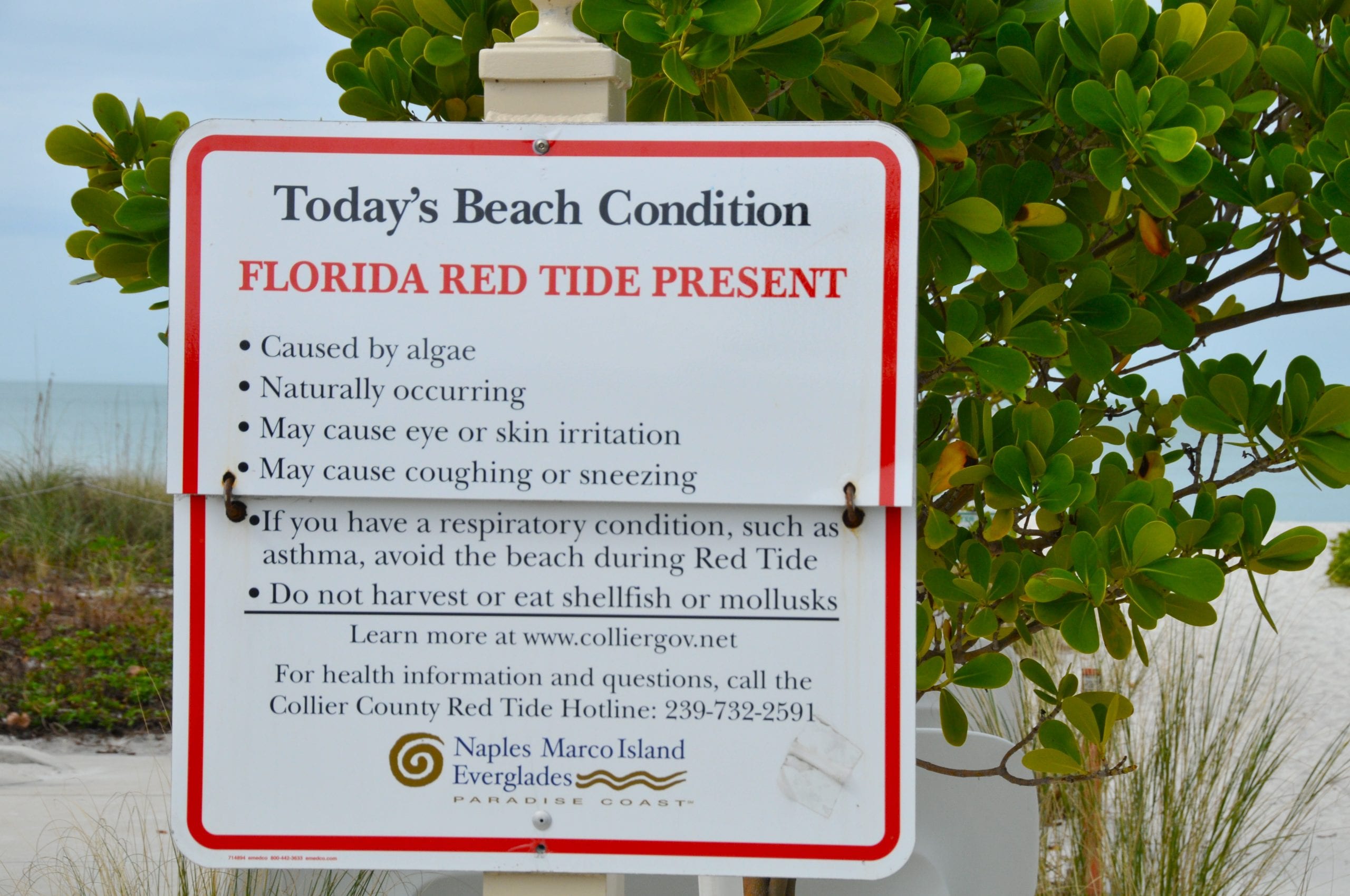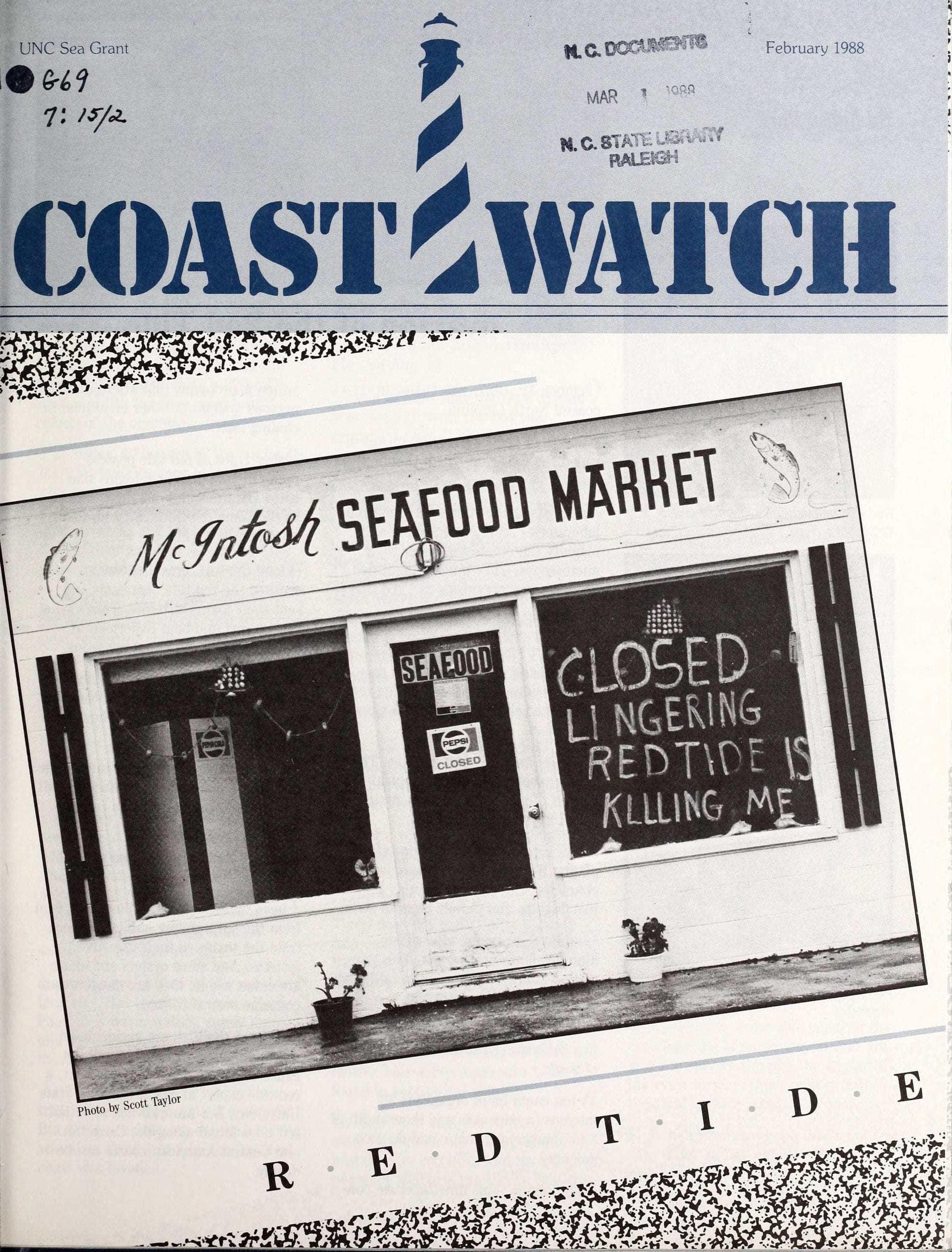Red Tide: Swimming not recommended.
Shellfish harvest closed.

Signs, such as in the associated picture, can be seen at many of Florida’s Gulf Coast Beaches due to a red tide. An excess of toxic microscopic algae in the water is causing a hazard to wildlife, human health, and local businesses.
While the current bloom of harmful algae started around November 2017, the last few weeks have seen an increase in the abundance of this algae. Most recently the red tide has expanded northward to the Florida panhandle. These recent blooms have resulted in reports of dead fish, sea turtles, dolphins, and a whale shark. In addition to the effects of marine life the red tide has also impacted local businesses through closed fisheries and a lack of tourists.
Florida's Governor Rick Scott has declared a state of emergency for the areas that have been impacted by the current red tide. This Executive order includes allocating $100,000 to Mote Marine Laboratory to support their efforts of continued monitoring of the algal bloom, rescuing and treating distressed animals including manatees, dolphins, and sea turtles. Counties affected by the red tide will benefit from a $500,000 grant program being established through VISIT FLORIDA to support tourism development boards. Lee County will receive an additional $900,000 in grants to help clean the waterways.
The cause of this red tide is Karenia brevis a type of single celled algae that is commonly found in the waters of the Gulf of Mexico and produces brevetoxin, a neurotoxin that causes neurological problems. While K. brevis is naturally occuring in the Gulf, under certain conditions, including warm waters and high levels of nutrients in the water, the algae can bloom by rapidly increase the number of individual algae in an area. In the case of K. brevis, these blooms are called “red tides†because of the associated change in water color. A red tide, or any algal bloom of a species that produces a toxin, is more generally called a Harmful Algal Bloom (HAB). While red tides tend to occur or become more intense during the fall there are complicated combinations of nutrient levels, wind patterns, temperature, currents and other factors that can make blooms difficult to predict.

K. brevis produces brevetoxin, which normally doesn't cause marine life too many problems at low concentrations; but when there is a red tide, the algae is abundant, resulting in dangerously high levels of brevetoxin. When animals consume brevetoxin it interferes with the function of their neurons, causing disorientation and eventually death. During blooms accumulation of brevetoxin causes massive die offs of fishes, as well as strandings and deaths of sea turtles and marine mammals. People should also exercise caution around red tides; consuming seafood that has ingested the toxin can cause the same problems in humans. In addition to the risks associated with eating brevetoxin, it can also affect the respiratory system if inhaled.
Today, I issued an emergency declaration to help SW FL and Tampa Bay area combat impacts from red tide. We're directing $100,000 for @MoteMarineLab & $500,000 for @VISITFLORIDA. I'm also directing an additional $900,000 for Lee County Cleanup Efforts https://t.co/YNJYqvWZmF
— Rick Scott (@FLGovScott) August 13, 2018
Coastal Floridian communities depend heavily on tourism to maintain their economy. Many small businesses have suffered from a lack of customers during the red tide. Restaurant owners have had cut back employee hours or even layoff part time workers. Meanwhile some hotels have been offering discounts to encourage guests to come to the affected areas.
During a red tide, be mindful of signs posted about current hazards and check the Harmful Algal Bloom Forecast. While the current blooms appears to be sticking around for awhile; it will not be a permanent feature of the Florida gulf coast. Once the current algal bloom subsides, Florida communities will have to cope with long term problems, such as a reduced stock size of commercially important fish species and the prospect of future red tides that will further worsen Florida's current situation.
 Karen Bobier is a Ph.D. candidate in the Department of Genetics studying populations of freshwater fishes in North Georgia and the evolution of DNA methylation genes. In her spare time she enjoys reading, hanging out with her dog, and is a member of the Red and Black Archery Club. You can email her at Karen.bobier25@uga.edu. More from Karen Bobier.
Karen Bobier is a Ph.D. candidate in the Department of Genetics studying populations of freshwater fishes in North Georgia and the evolution of DNA methylation genes. In her spare time she enjoys reading, hanging out with her dog, and is a member of the Red and Black Archery Club. You can email her at Karen.bobier25@uga.edu. More from Karen Bobier.
About the Author
- athenssciencecafehttps://athensscienceobserver.com/author/athenssciencecafe/April 17, 2020
- athenssciencecafehttps://athensscienceobserver.com/author/athenssciencecafe/April 12, 2020
- athenssciencecafehttps://athensscienceobserver.com/author/athenssciencecafe/April 3, 2020
- athenssciencecafehttps://athensscienceobserver.com/author/athenssciencecafe/March 30, 2020







